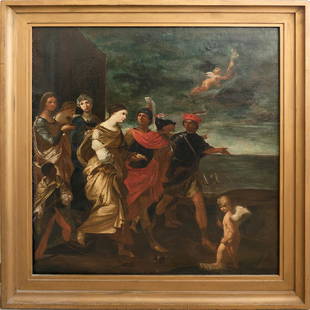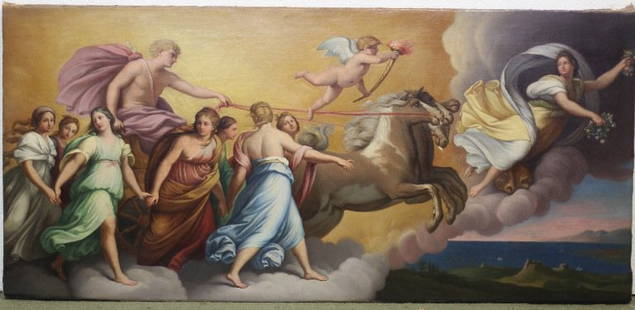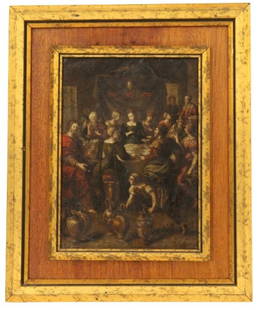
Italo-Flemish Master, 17th century, Mythological representation
Similar Sale History
Recommended Items







Item Details
Description
Italo-Flemish Master
17th century
Mythological representation
Oil on canvas, relined
119 x 170 cm
This enigmatic painting of the 17th century shows a dialogue between two figures, probably of biblical origin, in the middle of a ruinous rocky landscape that resembles a cave. A seated warrior clutches a saber with his left hand and has his right hand raised, probably reaching for the vessel that the older man holds in his hand. The latter, however, points to the golden, richly decorated chariot in front of which two horses are harnessed. The carriage is enveloped in a mystical dark mist or smoke; behind it the view of vegetation and an idyllic sky is revealed. On the right half of the picture, however, the remains of a Roman-looking temple are shown: Fragments of entablature with typical dentil frieze and parts of capitals lie in the shadowed foreground, while two angular column bases with broken, stone column shafts and two metal basins with lion-like mascarons, from which water flows into a basin, are located behind the group of figures. This could be the Temple of Solomon, with the pair of columns Jachin and Boaz in the forecourt of the temple, and here two fountain basins reminiscent of the Brazen Sea, a large bronze water basin for ritual purification. It seems that the warrior either settled here for rest and refreshment or fought here, which could refer to the destruction of this first temple as a result of the conquest of Jerusalem in 587 BC by the Babylonian king Nebuchadnezzar II.
However, the group of figures has strong similarities to the popular pictorial theme of the Good Samaritan. This New Testament narrative (Luke 10:25-37) contains a parable about loving one's neighbor, which is linked to loving God. Jesus tells of a Samaritan, a member of a religious community, who took pity on an injured and plundered man on his way from Jerusalem to Jericho and brought him to the inn on his horse. Already in paintings of the 17th century the Samaritan is shown as an older man with a long white beard as well as with a turban, who treats the wounds of the injured man with an ointment vessel. A 19th century wood engraving by Julius Schnorr von Carolsfeld (1860) also testifies to the continuation of this type of figure. However, this image theme seems to have been modified here due to the two-legged team as well as the clothing of the seated figure, which is otherwise only scantily clad and depicted almost fainting.
The seated figure wears an eclectic Roman-Turkish costume and is identified as a warrior or soldier; not least because of the saber and the shield, a Roman scutum or "tower shield" (rectangular, curved wooden shield), which was part of the equipment of the legionaries of the Roman army. Furthermore, the warrior wears a rolled-up tunic on the upper part of the body and over it a lorica segmentata (limb, splint or brace armor), which was used since the beginning of the 1st century AD. High metal shoes, possibly elaborated caligae or marching boots, complete the overall appearance. The red fabric curved over the right shoulder and left foot could represent a paludamentum, a general's and soldier's cloak that served as a badge of rank. However, the figure is not wearing a Roman helmet, but a white turban with tassels. Together with the facial physiognomy of the man, who has a moustache, this representation rather points to a Turkish costume.
17th century
Mythological representation
Oil on canvas, relined
119 x 170 cm
This enigmatic painting of the 17th century shows a dialogue between two figures, probably of biblical origin, in the middle of a ruinous rocky landscape that resembles a cave. A seated warrior clutches a saber with his left hand and has his right hand raised, probably reaching for the vessel that the older man holds in his hand. The latter, however, points to the golden, richly decorated chariot in front of which two horses are harnessed. The carriage is enveloped in a mystical dark mist or smoke; behind it the view of vegetation and an idyllic sky is revealed. On the right half of the picture, however, the remains of a Roman-looking temple are shown: Fragments of entablature with typical dentil frieze and parts of capitals lie in the shadowed foreground, while two angular column bases with broken, stone column shafts and two metal basins with lion-like mascarons, from which water flows into a basin, are located behind the group of figures. This could be the Temple of Solomon, with the pair of columns Jachin and Boaz in the forecourt of the temple, and here two fountain basins reminiscent of the Brazen Sea, a large bronze water basin for ritual purification. It seems that the warrior either settled here for rest and refreshment or fought here, which could refer to the destruction of this first temple as a result of the conquest of Jerusalem in 587 BC by the Babylonian king Nebuchadnezzar II.
However, the group of figures has strong similarities to the popular pictorial theme of the Good Samaritan. This New Testament narrative (Luke 10:25-37) contains a parable about loving one's neighbor, which is linked to loving God. Jesus tells of a Samaritan, a member of a religious community, who took pity on an injured and plundered man on his way from Jerusalem to Jericho and brought him to the inn on his horse. Already in paintings of the 17th century the Samaritan is shown as an older man with a long white beard as well as with a turban, who treats the wounds of the injured man with an ointment vessel. A 19th century wood engraving by Julius Schnorr von Carolsfeld (1860) also testifies to the continuation of this type of figure. However, this image theme seems to have been modified here due to the two-legged team as well as the clothing of the seated figure, which is otherwise only scantily clad and depicted almost fainting.
The seated figure wears an eclectic Roman-Turkish costume and is identified as a warrior or soldier; not least because of the saber and the shield, a Roman scutum or "tower shield" (rectangular, curved wooden shield), which was part of the equipment of the legionaries of the Roman army. Furthermore, the warrior wears a rolled-up tunic on the upper part of the body and over it a lorica segmentata (limb, splint or brace armor), which was used since the beginning of the 1st century AD. High metal shoes, possibly elaborated caligae or marching boots, complete the overall appearance. The red fabric curved over the right shoulder and left foot could represent a paludamentum, a general's and soldier's cloak that served as a badge of rank. However, the figure is not wearing a Roman helmet, but a white turban with tassels. Together with the facial physiognomy of the man, who has a moustache, this representation rather points to a Turkish costume.
Buyer's Premium
- 30%
Italo-Flemish Master, 17th century, Mythological representation
Estimate €3,000 - €5,000
1 bidder is watching this item.
Shipping & Pickup Options
Item located in Vienna, Vienna, atSee Policy for Shipping
Local Pickup Available
Payment

Related Searches
TOP







































![[ARCHAEOLOGY]. RAMBOVA, Natacha, editor. Egyptian Religious Texts and Representations. 1954-1957.: [ARCHAEOLOGY]. RAMBOVA, Natacha (1897-1966), editor. Egyptian Religious Texts and Representations. New York: Pantheon Books, 1954-1957. 3 works in 5 volumes, folio. Includes: The Tomb of Ramesses VI.](https://p1.liveauctioneers.com/197/329395/177650309_1_x.jpg?height=310&quality=70&version=1715364962)










